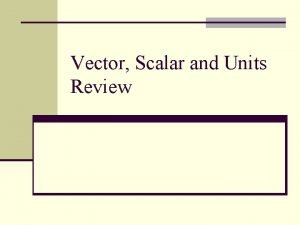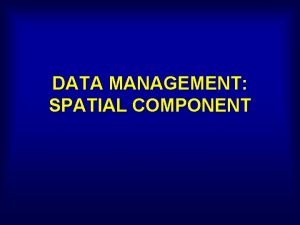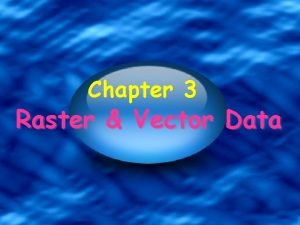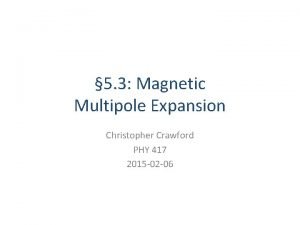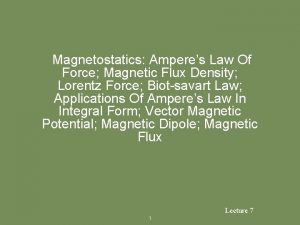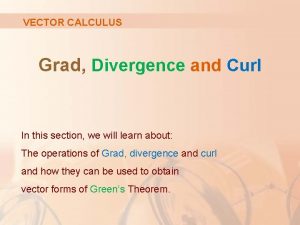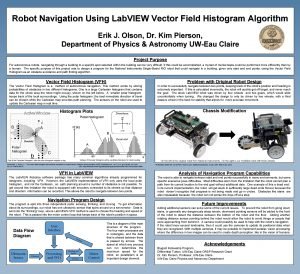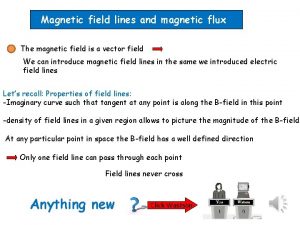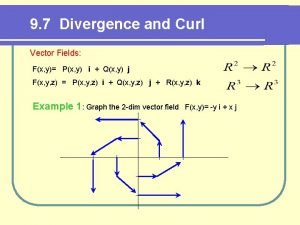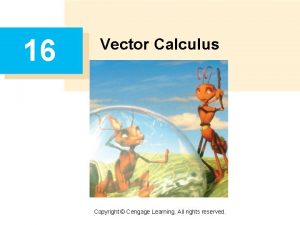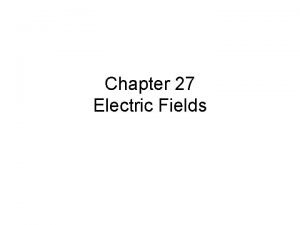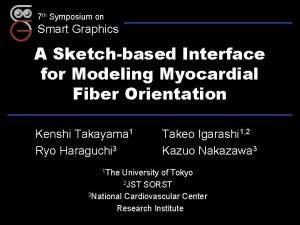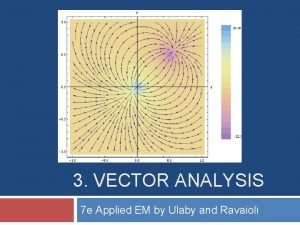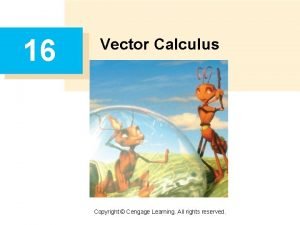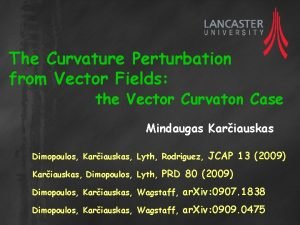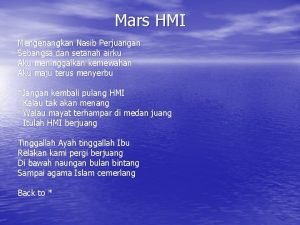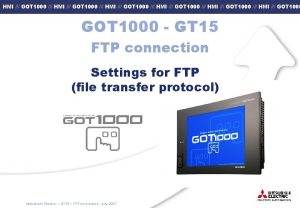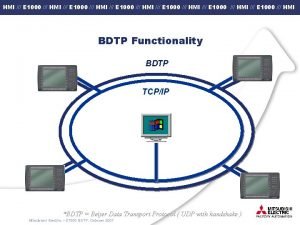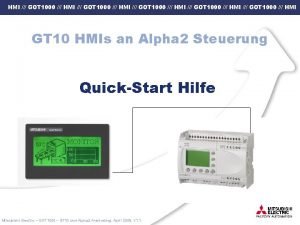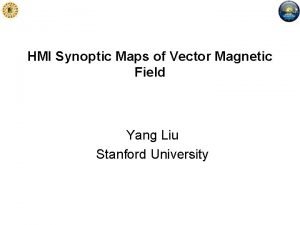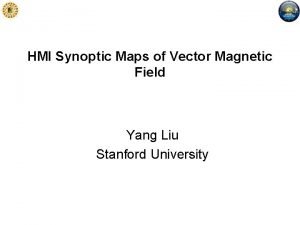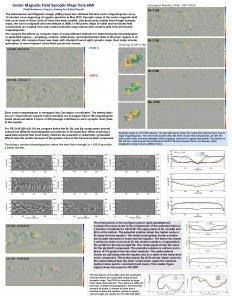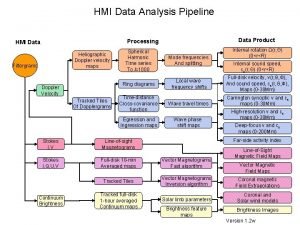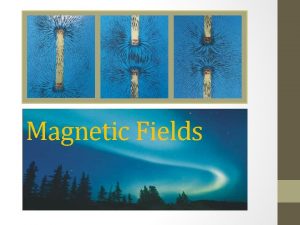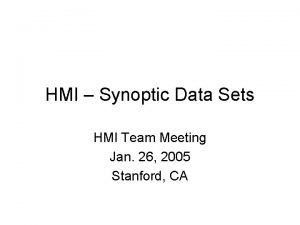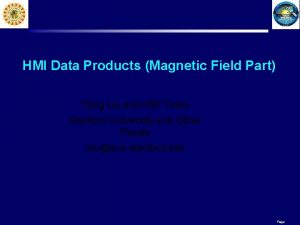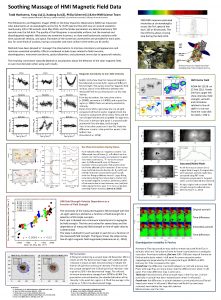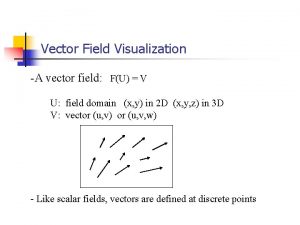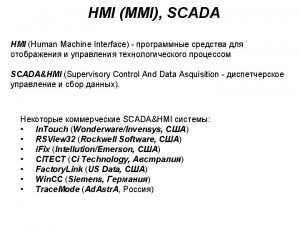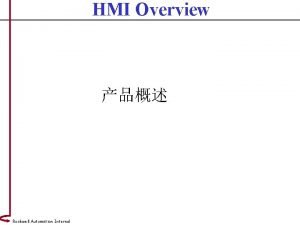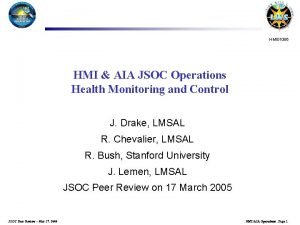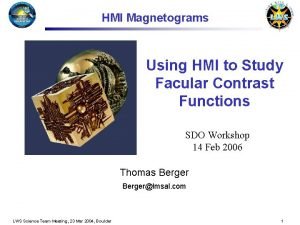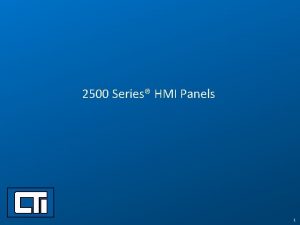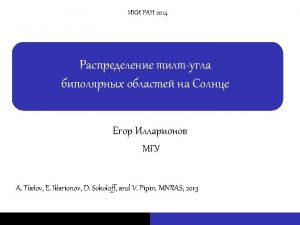HMI Magnetic Data Summary Determining vector magnetic field





























- Slides: 29

HMI Magnetic Data Summary • Determining vector magnetic field is biggest single computing challenge – Problem is bounded • Different anaylsis model than Doppler Data – Not all data are analyzed to same degree • Level 2 products are open ended – Resolution, cadence, quality, algorithms – Some in research state

HMI Data HMI Science Analysis Plan Processing Observables Data Product Science Objective

JSOC - HMI Pipeline HMI Data Level-0 Level-1 HMI Data Analysis Pipeline Processing Data Product

Magnetic Fields




Magnetic Processing Scheduling Three kinds of processing scheduling • Standard – Routinely completed for all data on regular cadence (e. g. Vector B) • On Demand – Completed for small fraction of data when interesting things happen or whenever requested by a qualified user (Hi. Res MHD time series for a big flare & CME campaign • On Request – Completed when system resources allow

Line-of Sight Magnetic Field

Vector Magnetic Field Needs additional FTE

Vector Magnetic Field Processor Summary • Processors – – – 32 (field inversion) 8 (low-res global MHD) 8 (hi-res local MHD), <10 (slow disambiguation) ~2 (fast disambiguation) <1 (rebinning/averaging), ? ? ? (coordinate transformation/remapping), <1 (calibration), 0 (hi-res global MHD – runs at CCMC), ? ? ? (NLFFF) – on demand/request - 40 CPU hours per run <1 (Solar wind models)

HMI Data Magnetic Data Products Magnetic Observables THoeksema YLiu THoeksema, JSchou, HAO YLiu, Schrijver YLiu, JSchou, *HAO JBeck, YLiu, RBush, JSchou XPZhao, KHayashi

Incomplete Magnetic Topic Group Affiliations (September, 2007) Tachocline - AKosovichev Meridional Circulation - AKosovichev Differential Rotation - AKosovichev Near-surface Shear Layer - JBeck Activity Complexes – Benevolenskaya, Bai, Hoeksema, Hayashi, Hurlburt, Gaizauskus, JHarvey Active Regions – THoeksema, EBenevolenskaya, TBai, KHayashi, NHurlburt Sunspots – TBai, THoeksema, EBenevolenskaya, NHurlburt Irradiance Variations – RBush, TBerger, PBoerner Magnetic Shear – YLiu, JBeck, KHayashi, AKosovichev, VYurchyshyn Flare/CME Magnetic Config – Hayashi, LM, YLiu, XPZhao, Bai, Kosovichev, UC-B, HWang Flux Emergence – YLiu, JBeck, Benevolenskaya, Hayashi, LM, BLites, Leka, HWang Mag. Carpet & Heating [AIA#1] – KHayashi, KSchrijver, JBeck, EBenevolenskaya Coronal Energetics [AIA] – KSchrijver, YLiu, Benevolenskaya, XPZhao, Hayashi, Leka, MCheung, UC-B, HWang Large-scale B – Ph. + Cor. - KHayashi, THoeksema, EBenevolenskaya, XPZhao Solar Wind – Evol+Struct. - Hayashi, Hoeksema, XPZhao, MWSO, CISM, Fuselier, Mikic Far-side Activity – PScherrer, CLindsey, DBraun, SAIC Predicting AR Emergence - TBai IMF Bs Events – XPZhao, YLiu, KHayashi, VYurchyshyn, Hu, SFuselier, ZMikic Magnetic Topology – YLiu, MSU-DLongcope, Barnes, SAIC-Titov Polar & Multi-scale Field – EBenevolenskaya, THoeksema

AIA Level-2

Details Charts

Velocity maps of magnetic footpoints • • • Pipeline: Velocity maps of magnetic footpoints. Lead by: UC Berkeley (Fisher & Brian) and Yang Task: Summary: based on the Local Correlation Tracking (LCT) technique, using time-series line-of-sight magnetograms to derive motion of magnetic footpoints. Input: time-series line-of-sight magnetograms. Output: velocity map with a cadence of 10 minutes. Generate on-demand temporarily (? ) stored. Code: LCT code developed by Fisher & Brian. Processors Status: almost ready to port. Already apply to MDI mags. Issues: some minor issues.

Vector magnetic field maps • • • Pipeline: vector magnetic field maps. Lead by: Todd & Yang & K. D. Leka. Task: Summary: based on algorithms (fast and slow) to solve 180 -degree ambiguity, and to map the vector magnetic field on solar surface (spherical coordinates). Input: field strength, inclination, azimuth, and filling factor. Output: Br, B_theta, B_phi at a 5 -minute cadence with fast algorithm (routine), 6 hour (? ) cadence with slow algorithm, and 30 -minute cadence with slow algorithm for active regions. Code: developed at Boulder. Processors Status: Codes for fast and slow algorithms are available. Issues: The code of slow algorithm is too slow, and loss of its author will lead an improvement very difficult. The code of fast algorithm works for Cartesian coordinate only. Need to extend to a spherical coordinate.

Synoptic magnetic field maps • • • Pipeline: synoptic magnetic field maps. Lead by: Todd & Xuepu. Task: Summary: based on line-of-sight magnetograms to generate synoptic maps of magnetic field. Input: remapped line-of-sight magnetograms. Output: Carrington synoptic charts (routine), synoptic frames with a cadence of as high as 1 minute (on-demand), evolved synoptic maps with a cadence of 16 minutes (routine). Code: at Stanford. Processors Status: almost ready to port. Already apply to MDI mags for Carrington rotation charts. Issues: some minor issues for synoptic frame and evolved maps.

Coronal & solar wind models • • • Pipeline: coronal & solar wind models. Lead by: Linker & Zhao & Hayashi Task: Summary: MHD simulation to model coronal structure (steady state) with vector field data as an input. Also seek dynamic solutions driven by timeseries data. Empirical solar wind models from PFSS-like result computed from magnetic field synoptic maps (i. e. WSA model); MHD solar wind model from synoptic maps. Input: vector magnetograms for local regions and vector field synoptic maps. Output: 3 D plasma data. Code: Potential field codes at Stanford, global MHD solution at SAIC, local MHD code provided by Wu at Alabama (in Fortran, one processor, 15 CPU hours for 99 x 99; not allow parallel computation) (and Abbete at Berkeley ? ) Processors: Status: Issues:

Coronal field extrapolation • • • Pipeline: coronal field extrapolation. Lead by: Schrijver & Keiji & Yang Task: Summary: based on potential field and force free field models to compute coronal field from vector magnetograms. Also seek possible MHD solutions. Input: vector magnetograms for local regions and vector field synoptic maps. Output: one global NLFFF solution (3 D vector field) per day, one global MHD solution (3 D vector field) per day, one PFSS & HCCSSS solutions (3 D vector field) per day. Global solutions and solutions(3 D vector field) for local region with a cadence as high as the data temporary resolution (on-request). Code: Potential field codes at Stanford, NLFFF provided by Thomas Wiegelmann at Germany (in C, on a 4 processor machine, for 320 x 256, 4 GB memory, 1 hour CPU time), global MHD solution at SAIC, local MHD code provided by Wu at Alabama (in Fortran, one processor, 15 CPU hours for 99 x 99; not allow parallel computation) (and Abbete at Berkeley ? ) Processors: Status: all codes are ready to port except MHD code for global solution with vector field data as input. Issues: global MHD simulation with vector field data as input needs to be tested. better visualization tool is required.

Magnetic-Fields Pipeline Status 11/5/2007

Vector Magnetic Field • Lead – Todd Hoeksema, Yang Liu • Task – – – – – Field inversion Azimuth disambiguation Vector magnetogram generation Coordinate transformation and remapping Calibration Synoptic chart/frame generation Potential field processing MHD processing NLFFF processing Solar wind model processing

Vector Magnetic Field (cont’d. ) • Input – Lev 0 data from both vector and LOS cameras, aligned, rebinned and averaged spatially/temporally – Dataseries names TBD • Level 1 Output – I, Q, U, V – data possibly saved in series size is 16 MPixels ea. – |B|, inclination, azimuth, filling factor – data saved in series TBD, size is 16 MPx ea. – Cadence for all is ~ 3 min. – Coordinate-transformer module is a deliverable

Vector Magnetic Field (cont’d. ) • Level 2 Output – Synoptic charts – data saved in series, cadence few per day, size 50 MPx – Frames – data saved in series, cadence hourly/varies, size 16 Mpx – Global potential field – data saved in series, cadence is 1 hr. , size is small – Local potential field – data saved, cadence is on-demand, size is small – Low res global MHD – saved for short durations in series, cadence is 1 day, size is ~ 1 MB – Hi res global MHD – data saved, cadence is few per month, size is small – Hi res local MHD – data saved, cadence is on-demand, size is moderate – MHD temporary/intermediate files – data saved for 2 weeks in series, size is 100 MB – Local NLFFF – data saved, cadence is on-demand, size is moderate – Solar wind models – data saved, cadence is few per day, size is small

Vector Magnetic Field (cont’d. ) • Code – – – – – Rebin/avg module (Rick? ) inversion code from HAO (S. Tomczyk, but we create module) “fast” azimuth-disambiguation module (Yang, Leka/CORA) “slow” azimuth-disambiguation module (Yang, Leka/CORA) coordinate-transformation/remapping (Yang) global potential field (Yang) local potential field (Yang) MHD (Keiji + SAIC) NLFFF (Yang + Keiji) Solar wind models (Todd + Yang)

Vector Magnetic Field (cont’d. ) • Processors – – – 32 (field inversion) 8 (low-res global MHD) 8 (hi-res local MHD), <10 (slow disambiguation) ~2 (fast disambiguation) <1 (rebinning/averaging), ? ? ? (coordinate transformation/remapping), <1 (calibration), 0 (hi-res global MHD – runs at CCMC), ? ? ? (NLFFF) – on demand/request - 40 CPU hours per run <1 (Solar wind models)

Vector Magnetic Field (cont’d. ) • Status – (how much is done), a NLFFF algorithm selected (IDL and C implementations exist) • Plan/Issues – – – – Are we saving I, Q, U, V products? Slow azimuth disambiguation algorithm TBD. Coordinate-transformation/remapping algorithm TBD. Calibration TBD. Synoptic charts/frames TBD. Global potential field processors and output data size unknown. Hi-res local MHD is TBD. Is time-evolved data used for NLFFF?

LOS Magnetic Field • Lead – Todd • Task – Generation of LOS magnetograms from lev 0 LOS data, generation of calibrated, radial LOS magnetic field maps from LOS magnetograms, generation of synoptic charts and frames • Input – Lev 0 data from LOS camera (dataseries) • Level 1 Output – Calibrated magnetic field map – data saved in series, cadence is 48 seconds, size is 16 MPx • Level 2 Output – ~ 450 Radial images – data not saved, cadence is 1 day, size is 4 MB ea. – 9 Charts + 18 diagnostic images (incl. off center) – data saved in series ? ? ? , cadence is 1 day, 7 MB ea. – Frames – data saved, cadence is hourly/on-demand, size is ? ? ?

LOS Magnetic Field (Cont’d) • Code – – Conversion to radial (Art) – MDI implementation exists Remapping (Rick/Art) – MDI implementation exists Chart creation (Keh-Cheng/Art) – MDI implementation exists Time-evolved chart creation (? ? ? ) • Processors – 1 (radialize), 1 (remapping), 1 (chart creation) • Status – MDI implementation exists for all code, except time-evolved chart creation, needs porting to JSOC (remapping mostly ported, needs testing) • Plan/Issues – MDI port complete in a couple of months; who is doing, time-evolved chart code, and schedule TBD?
 Is time a vector or scalar
Is time a vector or scalar Magnetic moment and magnetic field relation
Magnetic moment and magnetic field relation Magnetic flux density and magnetic field
Magnetic flux density and magnetic field Magnetic force particle
Magnetic force particle Electric field and magnetic field difference
Electric field and magnetic field difference Distinguish between magnetic and nonmagnetic materials
Distinguish between magnetic and nonmagnetic materials Magnetic field
Magnetic field Vector vs raster data
Vector vs raster data Vector data vs raster data
Vector data vs raster data Directed line segment definition
Directed line segment definition Vector unitario
Vector unitario How is vector resolution the opposite of vector addition
How is vector resolution the opposite of vector addition Define the position vector
Define the position vector Multipole expansion of vector potential
Multipole expansion of vector potential Magnetic flux density vector
Magnetic flux density vector Conservative field
Conservative field Vector field histogram
Vector field histogram Flux of a vector field
Flux of a vector field Divergence of f
Divergence of f Surface integral
Surface integral Electric field charge formula
Electric field charge formula Vector field sketcher
Vector field sketcher Length of a vector
Length of a vector Green's theorem formula
Green's theorem formula Vector field
Vector field Distinguish between soft and hard magnetic materials
Distinguish between soft and hard magnetic materials Hmi viggo
Hmi viggo Paradox cat hmi
Paradox cat hmi Paradox cat hmi
Paradox cat hmi Mars hmi
Mars hmi
